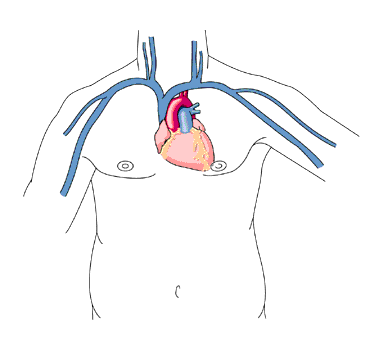HeartPoint animation: this will take approximately 90 seconds to load.

PACEMAKERS
HeartPoint animation: this will take approximately 90 seconds
to load.

This year, over 175,00 pacemakers will be implanted in patients in the United States. These devices are taken almost for granted, yet they are remarkable pieces of equipment.
In the animation above, a pacemaker is being placed. "Leads" which pass electrical charges to and from the heart are inserted into the large vein that runs under the collarbone and advanced to the chambers on the side of the heart that receives venous blood return. In real life, x-ray is used to help guide them. In this illustration, two leads are used, one placed in the upper chamber (right atrium), and the other into the lower chamber (right ventricle). The "pulse generator", which is the brains and contains the batteries used to power the pacemaker, is connected to the leads, and then placed in a "pocket" under the skin near the collarbone, the most common place of insertion of modern pacemakers. The pulse generator then sends energy down the leads which "captures" the heart muscle: that is, causes it to depolarize, illustrated here by turning a blue color. This electrical activity will stimulate the contraction of the heart muscle which is necessary for its pumping action. With two leads in place, the normal activation sequence of atrium first followed by ventricle is maintained.
Today's pacemakers sense the electrical activity which the heart is generating on its own, and only deliver electrical impulses if they are needed. Despite vast and ongoing improvements in technology, the average, or most common pacemakers implanted today is one which simply keeps the heart from beating too slow. It does not correct irregular beating, nor does it prevent the heartbeat from going too fast.
©COPY 1997 HeartPoint Updated February 1998To learn more about these modern miracles, read on.
| Commentary |
Food You Will Love | HeartPoint
Gallery | In The News | Health Tips | What's New
| Information Center | Home
|
This site presents material for your information, education and entertainment. We can assume no liability for inaccuracies, errors, or omissions. Above all, material on this site should not take the place of the care you receive from a personal physician. It is simply designed to help in the understanding of the heart and heart disease, and not as a diagnostic or therapeutic aid. You should seek prompt medical care for any specific health issues. Please feel free to browse the site and download material for personal and non-commercial use. You may not however distribute, modify, transmit or reuse any of these materials for public or commercial use. You should assume that all contents of the site are copyrighted. ©COPY;1997 HeartPoint